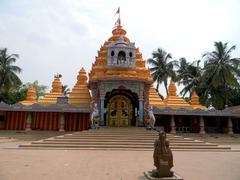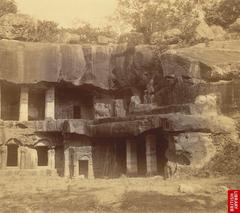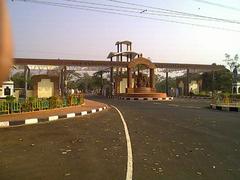A Complete Guide to Aisanyesvara Siva Temple: Visiting Hours, Tickets, and Bhubaneswar Historical Sites
Date: 04/07/2025
Introduction
Nestled in the sacred heart of Bhubaneswar, the Aisanyesvara Siva Temple is a remarkable testament to 13th-century Kalinga architecture and Odisha’s enduring Shaiva traditions. Although overshadowed by grander neighboring shrines like the Lingaraj Temple, Aisanyesvara offers visitors an intimate experience of Odisha’s temple heritage. This guide provides comprehensive, non-duplicative insights into the temple’s history, architectural significance, visitor information, conservation efforts, and nearby attractions, ensuring you make the most of your journey through the “Temple City of India” (Wikipedia, Odisha Tourism, Native Planet).
Table of Contents
- Overview and Religious Significance
- Historical and Architectural Features
- Visiting Hours, Entry, and Accessibility
- Rituals, Festivals, and Community Life
- Conservation and Sustainable Tourism
- Nearby Historical and Cultural Attractions
- Practical Tips for Visitors
- Frequently Asked Questions (FAQs)
- Visuals and Media
- Additional Resources and References
- Conclusion
Overview and Religious Significance
The Aisanyesvara Siva Temple, constructed under the Ganga dynasty in the 13th century, is dedicated to Lord Shiva as the guardian of the northeast direction—‘Aisanya’ in Sanskrit. Its presence in Bhubaneswar’s Old Town, a precinct with deep Shaiva roots, marks it as a vital spiritual and community hub. The temple remains an active site of daily worship, with rituals and festivals such as Maha Shivaratri and Kartika Purnima drawing devotees and celebrating Odisha’s vibrant religious life (Odisha Tourism).
Historical and Architectural Features
Historical Context
Built in the 13th century during the Ganga dynasty’s reign, Aisanyesvara Siva Temple reflects the zenith of the Kalinga architectural style. Its location amid a dense cluster of ancient temples underscores Bhubaneswar’s reputation as a center for Shaiva worship and temple architecture (Wikipedia, Native Planet).
Architectural Highlights
- Rekha Deul Style: The temple’s square sanctum and curvilinear spire typify the rekha deul form, featuring vertical offsets and a distinct crowning element.
- Decorative Motifs: Modest yet significant carvings, including miniature rekha deuls, udyota simha (lion motifs), and simple parsvadevata niches, adorn the exterior.
- Materials and Construction: Built with coarse-grained sandstone using dry masonry, reflecting both durability and local craftsmanship.
- Spatial Layout: Situated among other shrines and facing east, aligning with Hindu cosmological traditions.
- Sanctum and Ritual Objects: The original Shiva lingam is no longer present, but the yonipitha remains as the focal point of worship.
Visiting Hours, Entry, and Accessibility
- Visiting Hours: Open daily from 6:00 AM to 8:00 PM. During festivals, hours may extend to accommodate rituals (Orissa Tours).
- Entry Fees: No ticket or entry fee is required, ensuring accessibility for all visitors.
- Getting There: Located in Old Town Bhubaneswar, accessible by local buses, auto-rickshaws, and taxis. The nearest railway station is about 6 km away, and the Biju Patnaik International Airport is approximately 4 km from the temple.
- Accessibility: While the site is compact and reachable via city transport, access for differently-abled visitors may be restricted due to steps and uneven surfaces. Assistance can be arranged locally (Orissa Guide).
Rituals, Festivals, and Community Life
Daily worship (pujas) involves abhisheka (ritual bathing) of the lingam’s base, with offerings of water, flowers, and bilva leaves. Major festivals include:
- Maha Shivaratri: Night-long vigils, chanting, and special offerings, drawing large numbers of devotees.
- Kartika Purnima: Ritual baths and prayers for prosperity.
- Sankranti: Monthly observances with special pujas.
The temple also serves as a venue for community celebrations, rites of passage, and cultural events, reinforcing its role as a living center of faith and tradition (Cultural Odisha).
Conservation and Sustainable Tourism
Preservation Efforts
- Archaeological Survey of India (ASI): Oversees structural maintenance, cleaning, and restoration (ASI Bhubaneswar Circle).
- Community Stewardship: Local residents and NGOs participate in clean-up drives and awareness campaigns.
Challenges
- Urban Encroachment: Rapid city development threatens the temple’s visual and environmental context.
- Weathering: Monsoon rains and pollution erode stone surfaces.
- Limited Funding: As a lesser-known site, it receives less attention compared to major temples.
Sustainable Tourism Tips
- Dress modestly and respect sacred spaces.
- Remove footwear before entering the sanctum.
- Avoid flash photography and seek permission for photos.
- Carry reusable items and dispose of waste responsibly.
- Support local artisans and guides (Stamped Moments, Scribd Bhubaneswar Guide).
Nearby Historical and Cultural Attractions
Enhance your visit by exploring other significant sites in Bhubaneswar and nearby:
- Lingaraj Temple: The city’s largest and most celebrated Shiva temple.
- Mukteswara Temple: Renowned for its ornate gateway and carvings.
- Rajarani Temple: Notable for its reddish gold sandstone and sculptural elegance.
- Udayagiri and Khandagiri Caves: Ancient Jain rock-cut caves 7 km from the city center.
- Dhauli Shanti Stupa: Peace Pagoda marking the site of the historic Kalinga War.
- Nandankanan Zoological Park: Famous for its white tigers and botanical garden.
- Ekamra Kanan Botanical Gardens: Ideal for nature walks.
- Day Trips: Puri’s Jagannath Temple, Konark Sun Temple (UNESCO World Heritage Site), and Chilika Lake are all within an easy drive (TravelSetu, Thrillophilia, eBhubaneswar).
Practical Tips for Visitors
- Best Time to Visit: October to March for cooler, comfortable weather.
- Dress Code: Modest, covering clothing; remove footwear before entering.
- Facilities: Limited parking, no on-site restrooms; amenities available near Lingaraj Temple.
- Language: Odia is the local language; Hindi and English are also widely understood.
- Food and Water: Carry bottled water; eateries nearby serve local Odia cuisine.
- Photography: Allowed in outer areas; restricted inside the sanctum during rituals. Always seek permission.
Frequently Asked Questions (FAQs)
Q: What are the temple’s visiting hours?
A: 6:00 AM to 8:00 PM daily.
Q: Is there an entry fee?
A: No, entry is free.
Q: Are guided tours available?
A: Yes, local guides can be hired; heritage walks may include the temple.
Q: Is the temple accessible to differently-abled visitors?
A: Access may be challenging due to steps; local assistance is recommended.
Q: Can I take photographs?
A: Yes, in outer areas; seek permission inside the sanctum.
Visuals and Media
To enhance your understanding and trip planning, view high-quality images and virtual tours of the temple’s architecture and rituals through official tourism websites. Interactive maps and visual guides are available online (Orissa Tours).
Additional Resources and References
- Aisanyesvara Siva Temple Wikipedia
- Official Odisha Tourism Website
- Native Planet Bhubaneswar Guide
- Orissa Tours
- ASI Bhubaneswar Circle
- Stamped Moments: Bhubaneswar Travel Guide
- Scribd Bhubaneswar Tourist Guide PDF
- TravelSetu: Places Near Bhubaneswar
- eBhubaneswar: Tourist Places Near Bhubaneswar
- Thrillophilia: Places to Visit Near Bhubaneswar
- Cultural Odisha: Aisanyesvara Siva Temple
Conclusion
Aisanyesvara Siva Temple stands as an enduring symbol of Bhubaneswar’s spiritual and architectural legacy. Its tranquil setting, living ritual tradition, and remarkable stonework invite visitors to step back in time and savor Odisha’s sacred heritage. By planning your visit with awareness—respecting sacred customs, supporting local conservation, and exploring nearby treasures—you contribute to the preservation of this unique cultural tapestry.
For more travel inspiration, updates, and personalized itineraries, download the Audiala app and follow us on social media.








